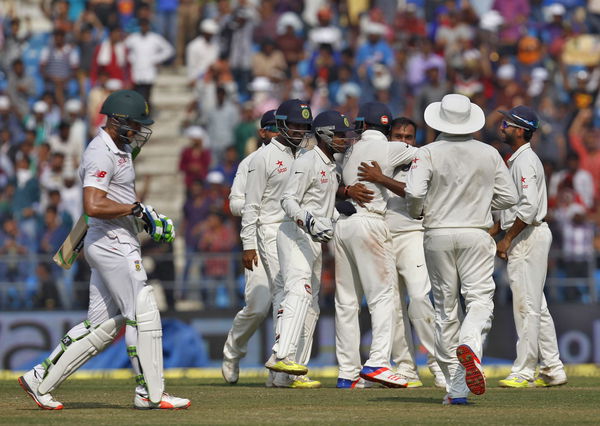
via Reuters
India’s Amit Mishra (3rd R) celebrates with his teammates after taking the wicket of South Africa’s Faf du Plessis (L) during the third day of their third test cricket match in Nagpur, India, November 27, 2015. REUTERS/Amit Dave

via Reuters
India’s Amit Mishra (3rd R) celebrates with his teammates after taking the wicket of South Africa’s Faf du Plessis (L) during the third day of their third test cricket match in Nagpur, India, November 27, 2015. REUTERS/Amit Dave
When we speak of a contest, we speak of an opportunity, an opportunity where all participating sides have equal opportunity to win. The Freedom Series between India and South Africa has been a lot of things, but no, not that!
Watch What’s Trending Now!
While most fans believe in the system of home advantage and every side has a right to that. So, Australia and South Africa can make pitches aiding bounce, England and New Zealand can make tracks with vicious swing/seam and West Indies, well they have every right to figure out what went wrong with their cricket in the last couple of decades. Similarly, India isn’t doing a sin when we prepare slow tracks that assist our spinners. But how do we know when we’ve gone too far?
This series was looked at as a battle between a young Indian side led by a dynamic and fierce leader and the mighty South African side, on the road for 9 years now, still undefeated, still unconquered. It was a clash of two of cricket’s modern day greats, a chance to see the world’s greatest seamer adjust to a new phase in his career, an opportunity for a young spin spearhead to prove his mettle and for countless others to just ‘shine’. . “Mushkil hai mazaa aayega”, was what the promotional tag line was. Sure India has won the series with a match still left but the series has hardly lived up to its billing, because of one reason: it hasn’t been allowed to.
ADVERTISEMENT
Article continues below this ad
A classic test match is always an equal contest between bat and ball. There should be something for everyone. The ball swings and carries on the first few days, if you grind and grind well as the batsman, your time to make merry comes too. And by late on the third day or so, cracks have developed and it’s Christmas, well if you are a spinner that is! That is where these turners fall flat, how can you explain the ball doing in the first hour what it is supposed to do late on third day?
Once upon a time, the Mohali pitch was the only pitch in India which had something in it for the seamers, both host and tourist alike. Cut to November 2015, R Ashwin, an off-spinner, is bowling with the new ball and the same Mohali track is dancing like a rattling snake, that too in the very first over of the Test match.
ADVERTISEMENT
Article continues below this ad
Perhaps that is the moment when we realize we’ve gone a little too far? Many remember the outrage fans felt at the trampoline in Durban in 1996 and the lawns in New Zealand in 2002. Indian fans were convinced those were unacceptable, and they were right. By the same argument, these pitches, especially the one in Nagpur, should be frowned upon too. They are not good for cricket and they are certainly not good for Indian cricket.
India have on their bench, two genuine quicks in Umesh Yadav and Varun Aaron. Essentially, India is telling them: ‘We don’t think you can win us the match’. India doesn’t have a good fast bowler, they shouldn’t complain why.
Another consequence of this is that India seems to be sending out the message that they can only win under a specific set of circumstances, even at home. You never allow your batsmen the opportunity to adapt, you never give your bowlers the chance to learn and you never let your test matches last FIVE days.

via Imago
Out of action!
(Image courtesy: cricketcountry.com)
Winning is supposed to mean something. You don’t get it simply decorated on a platter. You’re supposed to work for it, earn it. When you get it too easily, it loses its value. What it does to the Indian team is, it puts them in uncharted waters. India might win easily now, but the pedigree of our cricketers overall will be poor. Beyond this series, beyond this immediate result is a greater reality. Bad pitches might produce short-term results but will harm Indian cricket in the long run.
ADVERTISEMENT
Article continues below this ad
This Indian team is good enough to win on better surfaces. Let us show some faith in them.
ADVERTISEMENT
ADVERTISEMENT
ADVERTISEMENT
ADVERTISEMENT


